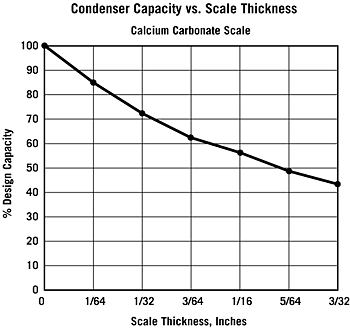Banks Tomas, a project engineer for Uni-Temp Refrigeration, Norcross, GA, addressed evap condenser efficiency in his session paper, “Operating A More Energy-Efficient Refrigeration System,” presented at the recent conference of the Refrigerating Engineers and Technicians Association (RETA).
Big redesigns may sound good, but Tomas pointed out that “Operators rarely have the luxury of making major design changes to their refrigeration system, and even if they do, it can sometimes take years to put into effect.
“In the interim, they must make the most of their system within the constraints of the maintenance budget.”
For condensers, this means lowering the discharge pressure.

HIGHER PRESSURE = HIGHER COSTS
Many factors affect discharge pressure, which then affects electrical consumption. Tomas gave the following example.Let’s say you have a 1,000-ton ammonia refrigeration system with a –20 degrees F suction temperature, designed to maintain an 85 degree discharge temperature/151.7-psig pressure during summer months. “However, due to various problems, you can only maintain your discharge temperature at 95 degrees, 181.1 psig,” Tomas said.
“If this condition existed through June, July, and August, in those three months alone your company would pay approximately $14,500 in additional electrical costs.” This is based on a $0.05/kWh rate and a run time of 540 hours/month.
“It is easy to see how quickly the costs can add up when your discharge pressure is higher than necessary,” he said. In addition to cost savings, when you reduce your system’s head pressure, you can achieve slightly higher compressor capacity ratings and “the potential for greater compressor life due to reduced compression ratio.”
The obvious answer, said Tomas, is to add more condenser capacity. But before you do that, make sure the existing condensers are operating at design capacity.
CHECK THE COILS
“Most people realize that coil condition is a factor in the effectiveness of a condenser,” Tomas stated, “but they may not realize how critical this aspect is.” The more scale, the lower the efficiency. (See Figure 1.)“Even with a scale accumulation of a mere 1/64th of an inch, the condenser is already operating approximately 15% below design capacity.” The solution is an effective water treatment program with regular monitoring.
Note: Make sure the company you select is familiar with your local water conditions.
Treatment should handle both scale and biological growth, Tomas said, plus other local conditions.
THE BENEFITS OF PURGING
Noncondensible gases, namely air, tend to accumulate in high-pressure areas, such as condensers and high-pressure receivers, Tomas pointed out.“Inside the condenser, the air displaces condensing surface area and acts as an insulator, effectively reducing the capacity of the condenser. Many people mistakenly believe they should only be concerned about air if their system runs in a vacuum,” he said. “Although systems in a vacuum are more susceptible to air problems, all systems accumulate air over time from performing maintenance or adding refrigerant to the system.” Oils also can break down under certain circumstances, forming noncondensible gases.
“The best way to remove noncondensibles is to install a purger,” Tomas said. There are several options available. “In most cases, these purgers offer a very attractive payback and should be strongly considered for all systems, whether running in a vacuum or not.”
PIPING ARRANGEMENT
Another area in which service and maintenance staff can improve evaporative condenser discharge pressures is through the piping arrangement.“Piping of evaporative condensers can be complicated,” Tomas advised, “and if you have any doubts, consult a quality refrigeration engineer or contractor.” He then offered the following recommendations.
Trapping: Liquid drain lines in a system with multiple condensers, or a single condenser with multiple coil sections, must be properly trapped.
“This eliminates the potential for liquid backup in condensers due to differing pressures that may exist at each condenser outlet,” Tomas said. “Any backup of liquid in the condenser reduces the effective capacity of the condenser.”
He suggested two methods for trapping multiple condensers:
1. If the liquid drain header enters the top of the receiver, each individual liquid drain line should have P-traps at the drain header.
2. If the liquid drain header enters the bottom of the receiver, each liquid drain line can tie directly into the header. P-traps aren’t needed, Tomas said, because “The entire header is effectively trapped.” None of the liquid drain outlets should be tied together until after the header.
Height: Ensure minimum height requirements between the trap and the condenser outlet.
“This height allows for any backup of liquid due to pressure differences between the condenser coils to occur in the vertical portion of pipe, not in the condenser coil,” Tomas stated.
Note: In bottom-feed receivers, the minimum height is the distance between the liquid outlet and the highest possible operating level in the receiver, not the drain header.
Valve locations: On condenser outlets, make sure valves and reducers are located in the vertical portion of the drain lines.
“Concentric reducers or globe valves in the horizontal portion of the liquid drain line immediately leaving the condenser can cause a liquid backup in the condenser,” Tomas said. “Locate these valves and fittings as low as possible in the vertical portion of the liquid drain line.”
HOW LOW CAN YOU GO?
Can your discharge pressure go too low? Perhaps.“At low discharge pressure, oil separators may not separate oil properly due to high velocities,” Tomas pointed out. “Usually, pressure down to 140 psig does not pose a problem.” If you find your system is below that level, consult your compressor/separator manufacturers.
Also, keep in mind that “Discharge pressure must remain high enough to allow for effective defrost conditions at your facility.
“Finally, in direct-expansion systems, discharge pressure may become too low to allow thermal expansion valves to work properly because of low pressure difference.”
Publication date: 11/18/2002

Report Abusive Comment